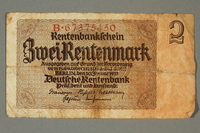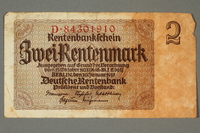Overview
- Description
- The Sam Kornhauser papers documents the experiences of the Kornhauser and Ament families in German-occupied Poland during World War II and consist of biographical materials and photographs documenting his parents, Stephen and Amalia Kornhauser, and members of the Kornhauser and Ament families who survived the Holocaust in Poland, Czechoslovakia, Hungary, and Belgium before immigrating to the United States and Brazil.
Biographical materials document Stephen and Amalia Kornhauser; Stephen’s siblings Leon Kornhauser, Fela Kornhauser, and Ursula Kornhauser Goldkorn and her husband Berek; his father Israel Kornhauser; and Amalia’s sister-in-law Manya Ament.
Stephen and Amalia Kornhauser materials primarily consist of false identification papers in the name Wizniewski, but they also include two 1938 patent documents in Stephen’s name (Salomon) for xylolite floors, one authentic 1950 travel document for Amalia, and the 1952 passenger list for the steamship Liberté bearing the names of the Kornhauser family (Salomon, Amalia, and Isidora).
Leon Kornhauser materials include a 1945 identification certificate; a 1952 passenger list showing his immigration to Brazil and a map of the port of Genoa; records documenting his crystal and glass coating business in Brazil in the 1950s; 1960s and 1970s correspondence from friends and relatives in Israel; and a 1998 letter about Kornhauser’s chance encounter with Pope John Paul II in the 1930s.
Ursula and Berek Goldkorn materials include identification papers from Poland, Germany, Belgium, and Brazil and a false certificate using the name Wizniewski. There is a similar false certificate for Fela Kornhauser.
This series also includes the personal narrative of Amalia Kornhauser’s sister-in-law, Manya Ament, describing the outbreak of war in Poland, the German occupation, the birth of Manya’s daughter Jeanine in the Bochnia ghetto, their escape to Czechoslovakia and Hungary, and liberation.
Photographs depict Kornhauser and Ament family members and friends in Poland, Belgium, and Germany, the opening ceremony of the Jewish Committee in Selb, Germany, in 1946, and the folding camp chair patented by Israel Kornhauser. This series also includes a photograph of four men in striped prisoner uniforms that is believed to represent Leon Kornhauser upon his liberation at Dachau. - Date
-
inclusive:
1930-1998
- Credit Line
- United States Holocaust Memorial Museum Collection, Gift of Sam Kornhauser
- Collection Creator
- Sam Kornhauser
- Biography
-
Sam Kornhauser was born Isadore Kornhauser in Belgium in 1947 to Polish Holocaust survivors Stephen
(Salomon) (1912-?) and Amalia (Ament) Kornhauser (1911-1989), who were born in Krakow. Amalia’s
family was confined to the Bochnia ghetto in 1941, and Amalia and Stephen were married in 1942.
Using a truck with a secret compartment, Stephen helped Amalia and several of her relatives, including
her sisters Sophie and Rose, Rose’s husband and son, her brother, her sister-in-law Manya Ament, and
her baby niece Jeanine escape the Bochnia ghetto. They fled through Czechoslovakia to Hungary, where
they survived the rest of the war. Stephen, Amalia, and Stephen’s sisters, Ursula and Fela, adopted false
identities under the name Wizniewski. Stephen and Amalia moved to Belgium after the war and
immigrated to the United States with their young son Sam in 1952. Amalia’s mother was shot dead
during an raid in the Bochnia ghetto in August 1942. Manya Ament’s sister Hanyia was sent to Szebnia
and then Auschwitz when the Bochnia ghetto was liquidated and died of typhoid in 1944. Sophie’s
husband, Dr. Arthur Haber, fought in the army of Polish expatriate soldiers led by Gen. Władysław
Anders, and the couple settled in England after the war. Stephen’s brother Chaim (Leon) Kornhauser
survived Plaszow, was liberated at Dachau, moved to Sao Paulo, Brazil in 1952, and worked as a chemist
specializing in crystal and glass coatings. Ursula Kornhauser and her husband, Berek Goldkorn, also
immigrated to Brazil after the war.
Physical Details
- Genre/Form
- Photographs.
- Extent
-
1 box
- System of Arrangement
- The Sam Kornhauser papers are arranged as two series: I. Biographical materials, 1935-1998, and II. Photographs, 1930-1965
Rights & Restrictions
- Conditions on Access
- There are no known restrictions on access to this material.
- Conditions on Use
- Material(s) in this collection may be protected by copyright and/or related rights. You do not require further permission from the Museum to use this material. The user is solely responsible for making a determination as to if and how the material may be used.
Keywords & Subjects
- Topical Term
- Jews--Poland--Kraków. Jewish ghettos--Poland--Bochnia. Identification cards--Forgeries--Poland. Holocaust, Jewish (1939-1945)--Personal narratives.
- Geographic Name
- Kraków (Poland) Bochnia (Poland) Selb (Germany) Brussels (Belgium) Ixelles (Belgium) São Paulo (Brazil)
- Corporate Name
- Dachau (Concentration camp)
Administrative Notes
- Holder of Originals
-
United States Holocaust Memorial Museum
- Legal Status
- Permanent Collection
- Provenance
- Sam Kornhauser donated his papers to the United States Holocaust Memorial Museum in 2005.
- Funding Note
- The cataloging of this collection has been supported by a grant from the Conference on Jewish Material Claims Against Germany.
- Record last modified:
- 2024-04-01 11:42:05
- This page:
- https://collections.ushmm.org/search/catalog/irn523232
Additional Resources
Download & Licensing
In-Person Research
- Available for Research
- Plan a Research Visit
-
Request in Shapell Center Reading Room
Bowie, MD
Contact Us
Also in Sam Kornhauser collection

2 Rentenmark Scrip
Object

2 Rentenmark Scrip
Object



